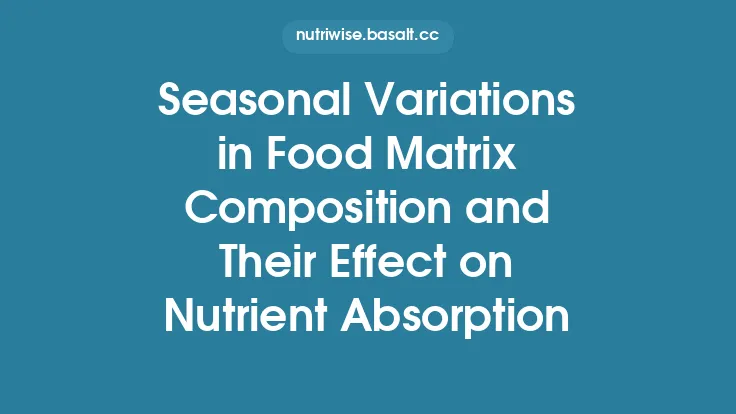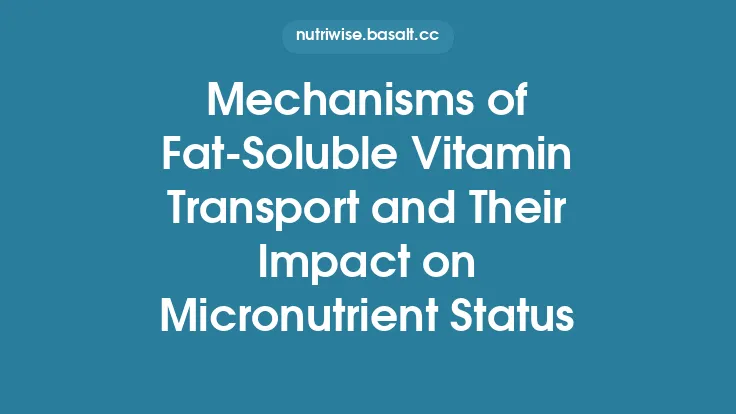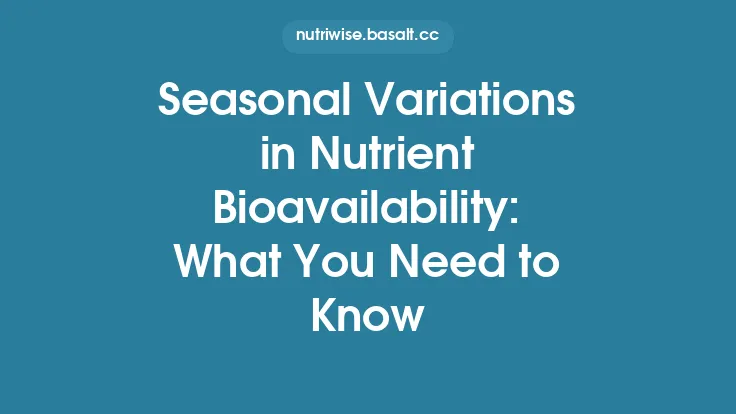Vitamin K is a fat‑soluble micronutrient that plays a pivotal role in maintaining the integrity of the vascular system and supporting the normal function of the coagulation cascade. While the biochemical actions of vitamin K are well documented, the amount of this nutrient that people actually consume can vary dramatically over the course of a year. Seasonal shifts in agricultural production, cultural eating patterns, and even climatic influences on food storage all contribute to fluctuations in dietary vitamin K intake. These variations, in turn, can subtly modulate blood‑related health markers such as clotting times, platelet reactivity, and vascular calcification propensity. Understanding the drivers of seasonal intake and the downstream physiological effects is essential for anyone seeking to preserve optimal blood health throughout the year.
Seasonal Patterns in Food Availability
Growing cycles and harvest windows
Most vitamin K‑rich vegetables belong to the leafy‑green and cruciferous families (e.g., kale, collard greens, Brussels sprouts, and mustard greens). In temperate regions, these crops are typically harvested in late spring through early autumn. Winter months see a sharp decline in fresh production, with growers relying on greenhouse cultivation or imported produce, which may have lower vitamin K concentrations due to longer post‑harvest storage times.
Regional climate influences
In Mediterranean climates, certain leafy greens (such as arugula and purslane) thrive during the cooler, wetter months, whereas in subtropical zones, year‑round production is possible for many vitamin K‑containing species. However, even in these regions, high temperatures can accelerate the degradation of vitamin K during transport and storage, leading to lower bioavailable amounts in the summer.
Cultural and culinary traditions
Seasonal festivals and traditional meals often dictate the consumption of specific foods. For example, many cultures feature hearty, root‑vegetable‑based stews in winter, which may contain fewer vitamin K‑rich leaves compared with spring salads. Conversely, springtime celebrations frequently highlight fresh greens, boosting intake during that period.
How Seasonal Diets Influence Vitamin K Intake
Quantitative fluctuations
Large‑scale dietary surveys have documented a 15–30 % swing in average daily vitamin K intake between the peak green‑leaf season and the off‑season. In regions where fresh produce is scarce during winter, the average intake can dip below the level required to sustain optimal plasma concentrations of vitamin K‑dependent proteins.
Bioavailability considerations
Vitamin K is lipophilic and its absorption is enhanced by dietary fat. Seasonal changes in overall dietary fat composition (e.g., higher saturated fat intake in winter) can either mitigate or exacerbate the impact of reduced vitamin K intake. Moreover, the matrix of the food (raw versus cooked) influences the release of vitamin K from plant cell walls; seasonal cooking practices (e.g., stewing versus raw salads) therefore affect the net amount absorbed.
Gut microbiota contributions
A portion of vitamin K2 (menaquinones) is synthesized by intestinal bacteria. Seasonal shifts in dietary fiber, probiotic foods, and overall macronutrient balance can remodel the gut microbiome, altering endogenous vitamin K2 production. For instance, higher consumption of fermented foods in winter may partially compensate for lower dietary vitamin K1 from greens.
Physiological Consequences of Fluctuating Vitamin K Levels on Hemostasis
Modulation of vitamin K‑dependent clotting factors
The liver synthesizes several clotting proteins (e.g., prothrombin, factors VII, IX, and X) that require γ‑carboxylation, a reaction dependent on reduced vitamin K. When circulating vitamin K falls, the γ‑carboxylation efficiency declines, leading to the production of partially carboxylated clotting factors with reduced activity. This manifests as modest prolongations in prothrombin time (PT) and international normalized ratio (INR) during low‑intake periods.
Impact on vascular calcification inhibitors
Matrix Gla‑protein (MGP) and osteocalcin are extra‑hepatic, vitamin K‑dependent proteins that inhibit ectopic calcification. Seasonal dips in vitamin K can reduce the carboxylated (active) fraction of MGP, potentially increasing the propensity for micro‑calcifications within arterial walls. While the effect is subtle, longitudinal data suggest a correlation between low winter vitamin K intake and a modest rise in arterial stiffness indices.
Platelet function and endothelial health
Emerging evidence indicates that vitamin K status influences platelet aggregation thresholds and endothelial nitric oxide production. Seasonal reductions in vitamin K may lead to a slight increase in platelet reactivity, which, when combined with other winter‑related risk factors (e.g., higher blood pressure and reduced physical activity), could contribute to the observed seasonal peaks in thrombotic events.
Epidemiological Evidence Linking Seasonal Intake to Blood Health Outcomes
Population‑based cohort studies
Large prospective cohorts in North America and Europe have reported a seasonal pattern in coagulation biomarkers: PT and INR values tend to be higher in winter months, coinciding with lower reported intake of vitamin K‑rich vegetables. Adjusted analyses that account for confounders such as vitamin D status, temperature, and physical activity still retain a significant association between season and coagulation parameters.
Cardiovascular event seasonality
Epidemiological surveillance consistently shows a winter excess in myocardial infarction and ischemic stroke incidence. While multifactorial, one contributing element appears to be the seasonal dip in vitamin K intake, which may exacerbate pro‑thrombotic tendencies. Studies that stratify participants by dietary patterns reveal that individuals maintaining higher winter vitamin K consumption (through preserved greens or fortified foods) experience a blunted rise in cardiovascular events compared with those whose intake drops sharply.
Intervention trials with seasonal supplementation
Short‑term randomized trials that provide winter‑time vitamin K supplementation (e.g., 100 µg of phylloquinone daily) have demonstrated normalization of PT/INR and a reduction in markers of vascular calcification (e.g., circulating desphospho‑uncarboxylated MGP). Although these trials focus on supplementation, they underscore the physiological relevance of maintaining adequate vitamin K levels during low‑intake seasons.
Strategies to Mitigate Seasonal Gaps
Planning for year‑round consumption of fresh greens
- Community-supported agriculture (CSA) and local farms: Engaging with growers who employ season‑extending techniques (high tunnels, cold frames) can secure a supply of fresh, vitamin K‑rich produce throughout winter.
- Urban gardening and indoor hydroponics: Home growers can cultivate leafy greens under controlled lighting, ensuring a steady intake independent of external climate.
Food preservation techniques that retain vitamin K
- Freezing: Rapid blanching followed by flash‑freezing preserves up to 90 % of the original vitamin K content.
- Fermentation: Sauerkraut, kimchi, and other fermented cabbage products not only retain vitamin K1 but also generate vitamin K2 through microbial activity.
- Drying and powdering: Dehydrated leaf powders can be reconstituted into soups or smoothies, providing a concentrated source of vitamin K with minimal loss.
Incorporating fortified products judiciously
While the article on supplementation is separate, the use of fortified staple foods (e.g., vitamin K‑enriched breads or cereals) can serve as a pragmatic bridge during periods when fresh greens are scarce. Selecting products that use natural phylloquinone rather than synthetic analogs ensures better bioavailability.
Dietary pattern adjustments
- Balanced macronutrient intake: Pairing vitamin K‑rich foods with healthy fats (olive oil, nuts) enhances absorption.
- Seasonal recipe rotation: Designing meal plans that rotate between raw salads in spring/summer and warm, leafy‑green stews in autumn/winter helps maintain consistent intake.
Role of Food Preservation and Fortification
Preservation methods not only extend shelf life but also influence the chemical stability of vitamin K. Vitamin K is relatively resistant to oxidation compared with other fat‑soluble vitamins, yet prolonged exposure to light and heat can degrade it. Modern packaging that limits oxygen ingress and utilizes opaque containers can preserve up to 95 % of vitamin K over several months. Fortification strategies that embed vitamin K within lipid matrices (e.g., emulsified oil droplets) improve its stability during processing and storage, making fortified foods a reliable source during off‑season periods.
Considerations for Special Populations
Older adults
Age‑related declines in digestive efficiency and alterations in gut microbiota can reduce vitamin K absorption and endogenous synthesis. Seasonal intake dips may therefore have a more pronounced impact on coagulation parameters in this group, necessitating proactive dietary planning or targeted fortification.
Individuals on low‑fat diets
Since vitamin K absorption is fat‑dependent, those adhering to very low‑fat regimens may experience suboptimal uptake even when intake is adequate. Seasonal variations in dietary fat (often higher in winter) can inadvertently mask underlying deficiencies.
Athletes and high‑performance individuals
Intense training can increase oxidative stress and turnover of clotting factors. Maintaining a stable vitamin K supply throughout the year supports efficient recovery and reduces the risk of exercise‑induced micro‑vascular injury.
Future Research Directions
- Longitudinal metabolomics: Tracking plasma levels of both phylloquinone and various menaquinones across seasons will clarify the kinetic relationship between intake, storage, and functional biomarkers.
- Microbiome‑vitamin K interplay: Controlled feeding studies that manipulate seasonal dietary fiber and fermented food intake can elucidate how gut‑derived vitamin K2 compensates for reduced plant‑derived vitamin K1.
- Genetic determinants of seasonal responsiveness: Polymorphisms in genes encoding vitamin K epoxide reductase (VKORC1) and γ‑glutamyl carboxylase may modulate individual susceptibility to seasonal fluctuations.
- Public‑health interventions: Community‑level programs that promote winter preservation techniques and fortified staple distribution could be evaluated for their impact on population‑wide coagulation metrics and cardiovascular event rates.
By recognizing that vitamin K intake is not a static daily figure but a dynamic variable shaped by the seasons, health professionals and individuals alike can adopt strategies that smooth out these fluctuations. Consistent exposure to adequate vitamin K supports the proper functioning of clotting factors, curtails inappropriate vascular calcification, and contributes to overall blood health, regardless of the time of year.





